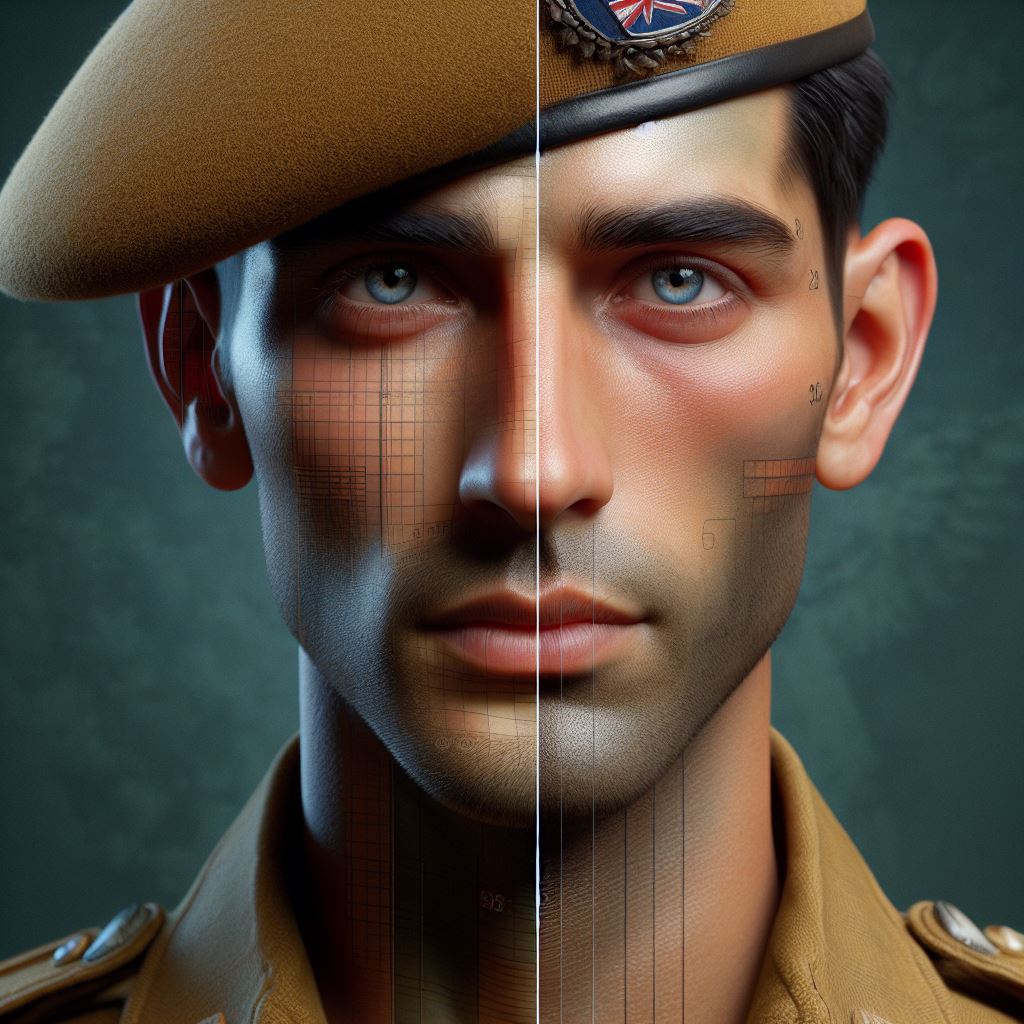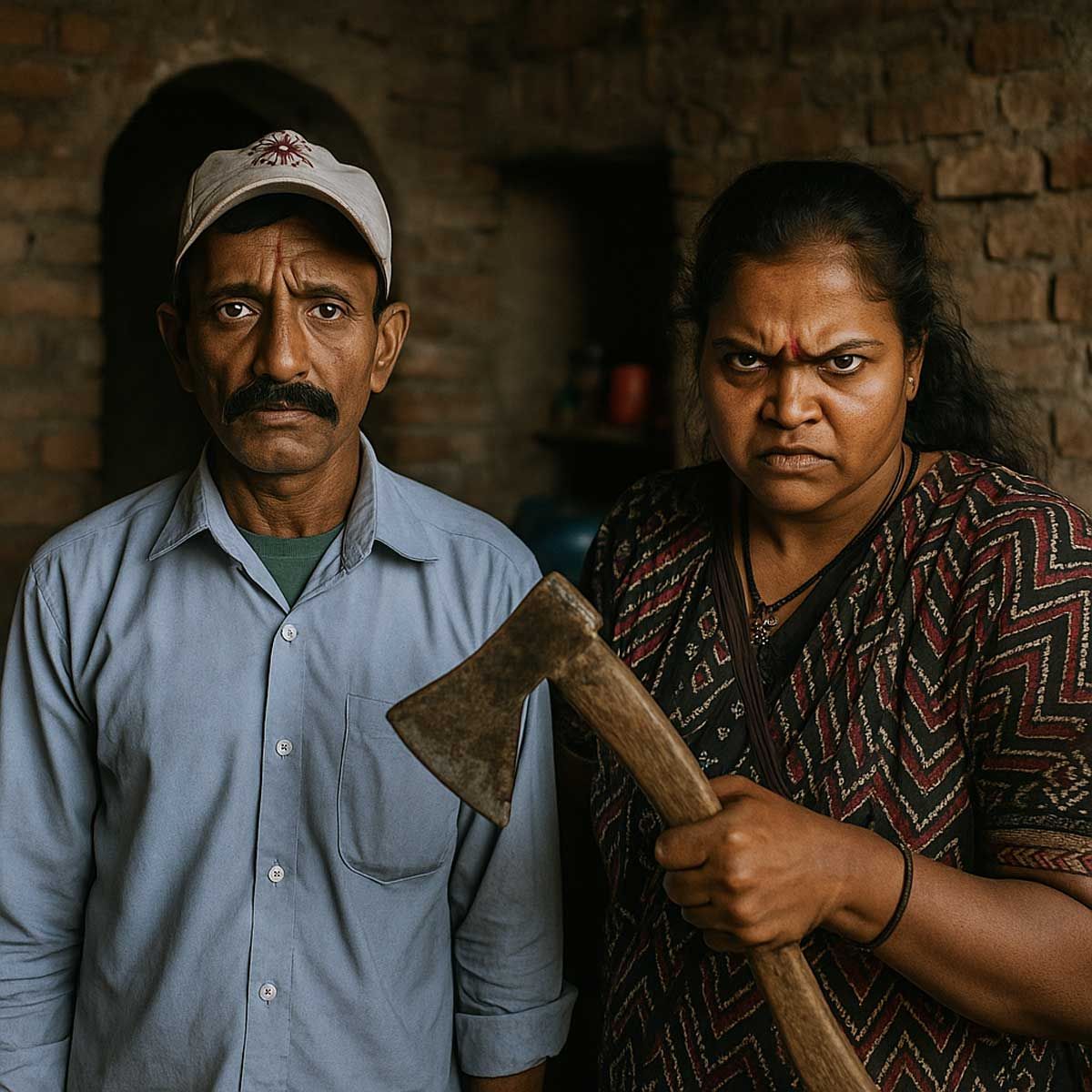More Coverage
Twitter Coverage
Satyaagrah
Written on
Satyaagrah
Written on
Satyaagrah
Written on
Satyaagrah
Written on
Satyaagrah
Written on
JOIN SATYAAGRAH SOCIAL MEDIA
Explore the mystery of 'Badluram ka Badan,' the haunting anthem of the Assam Regiment, concealing the tale of Badluram, it echoes resilience, sustaining camaraderie even beneath the earth; join the global symphony of sacrifice transcending borders

The rhythmic thud of boots hitting the ground, accompanied by a soul-stirring melody, resonates through the disciplined ranks of the Assam Regiment of the Indian Army. This regiment, renowned for its ferocity and unwavering dedication, stands tall among its counterparts. Emblazoned with the resounding tagline of "Tagde Raho" (Stay Strong), the Assam Regiment has etched a saga of valor since its inception in 1941, a tale as compelling as the anthem that accompanies its march.
Lt. Col. Ross Howman, the visionary architect behind the formation of the Assam Regiment, raised it with a singular purpose – to assert the dominion over the then undivided state of Assam. In the crucible of conflict, the regiment's mettle was swiftly tested just six months after its establishment. Summoned to defend the critical oil fields in Digboi, the Assam Regiment displayed unwavering resolve and courage in the face of adversity.
As the shadows of World War II loomed large, the regiment faced a pivotal moment in 1944. With the specter of a Japanese invasion haunting the eastern frontier, the Assam Regiment was strategically repositioned to Jessami and Kharasom. Here, amidst the rugged terrain and under the looming threat of an enemy advance, the regiment orchestrated a determined stand to impede the progress of the Japanese forces.
For their indomitable valor exhibited at Jessami and Kharasom, the Assam Regiment earned well-deserved battle honors. However, it was during the historic defense of Kohima that the regiment scripted its most defining chapter. The capture of Ardura stands as a testament to their prowess on the battlefield. In the crucible of war, the Assam Regiment earned 71 gallantry awards in its inaugural operation, a remarkable feat that underscored their commitment to duty. Additionally, they proudly adorned six battle honors, a recognition of their pre-independence achievements.
The legacy of the Assam Regiment is not merely confined to historical laurels; it reverberates through the cadence of a beloved marching song – "Badluram ka badan." This anthem encapsulates the spirit of the regiment, narrating tales of sacrifice, triumph, and unwavering commitment. As we delve into the origins of this marching song, we unravel not just a musical piece but a cultural artifact that binds the regiment in a harmonious cadence of shared history and pride.
But the tagline and their track record is not the only unique thing about this regiment. It is, in fact, their battle song. A gripping and emotional song that haunts your mind way after the notes have died and the air is silent.
Beyond the battlefield accolades and the resounding "Tagde Raho" that reverberates in their ranks, the Assam Regiment's uniqueness extends to a haunting melody – a battle song that transcends time and echoes through the corridors of history. This poignant anthem, titled "Badluram Ka Badan," is more than a mere musical composition; it is an emotional journey that lingers in the mind long after the last notes have faded, leaving an indelible mark on the hearts of those who hear it.
The song is called Badluram Ka Badan and is based around an erstwhile soldier in the Assam Regiment called Badluram. The lyrics of the song echo the sacrifice that this soldier and many others made in the wars that they were a part of.
At the heart of this musical masterpiece lies the persona of Badluram, an erstwhile soldier in the Assam Regiment whose story becomes the lyrical tapestry of the song. Through its verses, "Badluram Ka Badan" weaves a poignant narrative of sacrifice, immortalizing not just the individual Badluram but all the unsung heroes who stood shoulder to shoulder in the crucible of war. The lyrics serve as an eloquent tribute to the valor and sacrifice of soldiers, a testament to the indomitable spirit that defines the Assam Regiment.
The song is a way to remember these fallen, these greats who gave their lives for a cause higher than them.
"Badluram Ka Badan" is not merely a melody; it is a solemn pledge to remember and honor the fallen. It stands as a reverent homage to the greats who, in the pursuit of a cause greater than themselves, made the ultimate sacrifice. In each note and every haunting refrain, the song becomes a vessel for collective memory, ensuring that the legacy of these brave souls endures beyond the pages of history. It is a musical ode that transcends time, resonating with the solemnity of remembrance and gratitude for those who gave their all for a cause they held dear.
The legend goes like this: When the regiment was under siege at Kohima by the Japanese, they were under heavy attack. There was no way out, no way to get more supplies. But, they survived. And the only reason they did was that before the siege, their quartermaster was drawing supplies for soldiers who had already been martyred.
In the crucible of war at Kohima, the Assam Regiment found itself besieged by the relentless onslaught of the Japanese forces. In the face of heavy attack and with no apparent escape route, the situation seemed dire. The supply lines were severed, and the specter of scarcity loomed large. Yet, against all odds, they survived. The key to their resilience lay in a strategic move made before the siege unfolded. The regiment's quartermaster, foreseeing the challenges ahead, had been drawing supplies for soldiers who had already become martyrs. This foresight and sacrifice laid the foundation for the regiment's survival, turning the tide in their favor.
As a result, they had a surplus and were able to wait the siege out and plan out their attack without the scarcity of food.
The surplus of supplies, a testament to the strategic foresight of the quartermaster, became the lifeline for the besieged regiment. With ample provisions at their disposal, they could endure the siege, patiently biding their time and meticulously planning their counterattack. The absence of scarcity became a strategic advantage, allowing the Assam Regiment to navigate the challenges with resilience and determination.
The sacrifice of their fellow men and the ingenuity of the quartermaster was the only reason that the fledgling regiment survived and is what it is today. It literally owes its existence to the Badluram and it’s no surprise that they consider the rations his gift to them.
The survival and subsequent flourishing of the Assam Regiment find roots in the sacrifice of their fallen comrades and the ingenious foresight of the quartermaster. The regiment, in essence, owes its very existence to the indomitable spirit of Badluram and those who made the ultimate sacrifice. In a symbolic gesture, the rations drawn for the fallen soldiers are considered a gift from Badluram—a gesture that goes beyond the mundane act of rationing, embodying the spirit of brotherhood and sacrifice that defines the Assam Regiment.
The legend of the Assam Regiment at Kohima illuminates a profound truth about sacrifice—the fundamental reason behind it and the enduring value it holds in the hearts and minds of those left behind. The sacrifice made by individuals like Badluram becomes a beacon, a guiding light that shapes the ethos of the regiment. It is a narrative that transcends the battlefield, resonating with the deeper understanding that sacrifice, in its truest form, is a gift that echoes through time, shaping the destiny of generations to come.
In the annals of wartime sacrifice, the story of Badluram, a jawan in the Assam Regiment, unfolds against the backdrop of World War II in Japan, during a time when India was still under British rule. The narrative takes a poignant turn as we delve into the actions of the regiment's quartermaster. According to protocol, the quartermaster was tasked with reporting the deaths of soldiers to the authorities, leading to the cessation of rations for the fallen. However, in the case of Badluram, an exception was made. The quartermaster, whether by choice or an oversight, retained Badluram's name on the roster, allowing the fallen soldier to continue receiving rations. The reasons behind this act, whether deliberate or forgetful, add layers to the tale of sacrifice and resilience.
As the platoon faced the harrowing reality of being surrounded by Japanese troops that had entered India in 1944, the consequences of the quartermaster's actions became profoundly significant. Cut off from regular supplies, the extra rations drawn in Badluram's name emerged as a crucial lifeline for the besieged men. This surplus sustenance played a pivotal role in ensuring the survival of the platoon through the challenging siege. The lyrics of the anthem, "Badluram ka badan zameen ka neeche hai, toh humey uska ration milta hai," encapsulate the essence of this narrative, acknowledging that even in death, Badluram's sacrifice continued to nourish and sustain the regiment he once served. The song became more than a melody; it became a living testimony to the resourcefulness born out of sacrifice, echoing through the ages.
|
The universality of "Badluram ka badan zameen ke neeche hai" extends far beyond the borders of India, showcasing its impact on a global scale. In a heartening display of camaraderie, a group of Indian soldiers found resonance in their American counterparts as they jointly sang the Army's favorite marching song during a joint military exercise in the US. This cross-cultural union, where soldiers from different nations harmonize in song, underlines the power of shared experiences and common anthems to bridge gaps and foster understanding among military personnel worldwide. It exemplifies how the spirit encapsulated in a single marching song can transcend geopolitical boundaries, creating a moment of unity and shared identity.
In July, social media witnessed a viral phenomenon that captivated audiences worldwide. A video surfaced on Twitter, featuring a drill sergeant in Nagaland leading his troops in a unique drill to the tune of '"Dhal gaya din...," a 1970s hit song featuring Jeetendra and Leena Chandavarkar in the film Humjoli. The soldiers marched in unison, accompanied by quirky additions to the song, injecting humor and a sense of camaraderie into the drill. The video's virality underscored the universal appeal of music in fostering camaraderie and morale within military ranks. It serves as a testament to the enduring power of shared cultural references, even across decades and continents, to uplift spirits and forge connections in the most unexpected of settings.
Months after the heartwarming display of camaraderie during a joint military exercise in the US, a group of Indian soldiers once again found harmony with their American counterparts, this time singing the Indian Army's cherished marching song, 'Badluram ka badan zameen ke neeche hai.' The video capturing this cross-cultural moment quickly gained traction on social media, sparking conversations and resonating with audiences globally. This continued embrace of the marching song in international military settings emphasizes its enduring significance and ability to forge connections, transcending geographical and cultural boundaries.
Amidst the global conversations around military actions and geopolitical developments, the Indian Army has been under the spotlight, particularly in the context of Jammu and Kashmir and its neighboring areas. Events such as the Uri surgical strikes, Balakot air strikes, and the post-revocation of Article 370 in the Valley have drawn international attention to the Indian Army's activities and its strategic role in maintaining peace and security. The ongoing discourse surrounding these developments has heightened the importance of understanding and appreciating the role of the military, making the singing of 'Badluram ka badan zameen ke neeche hai' even more poignant as it symbolizes shared experiences and mutual respect among soldiers globally.
In the immersive setting of Exercise Yudh Abhyas 2019, a pivotal joint military training program exemplifying the ongoing Indo-US defense cooperation at Joint Base Lewis McChord, Washington, USA, captivating images and videos have emerged showcasing Indian and US soldiers seamlessly practicing drills together. Amidst the plethora of visual narratives, one particular moment has captured the affection of netizens, resonating deeply with the online community.
During this joint military exercise, a remarkable instance unfolded where Indian and American soldiers not only collaborated in drills but also broke into a dance, harmonizing their movements with the rhythm of a popular marching song dedicated to Badluram—a soldier in the Assam Regiment who made the ultimate sacrifice during World War II. This visual spectacle encapsulates the essence of camaraderie and mutual respect, transcending national borders and cultural differences. It serves as a powerful testament to the universality of shared experiences among soldiers, united by the spirit of a common anthem.
The chosen marching song, "Badluram ka badan zameen ke neeche hai," holds a historical resonance, drawing inspiration from the US Civil War song, The Battle Hymn of The Republic — John Brown's Body. The lyrics, culminating with the emphatic 'shabaash, hallelujah,' have become an iconic anthem for the Assam Regiment. This amalgamation of cultural influences and shared history is a poignant reminder of the enduring impact of music in fostering unity and camaraderie within military ranks. The soldiers' spontaneous dance adds a layer of joy to the solemnity of the moment, creating an indelible image of collaboration and shared humanity amid the rigors of military training.
Exclusive to specific military units, these marching songs serve a dual purpose in breaking the monotony and enhancing the precision of recruits during drills, as explained by an Indian Army official quoted by ThePrint. Beyond the functional aspect of maintaining cadence, these songs become a unique form of cultural expression within the military. 'Badluram ka badan zameen ke neeche hai' stands out as a testament to this tradition, weaving together history, sacrifice, and camaraderie. Its role goes beyond being a mere marching cadence; it is a living connection to the ethos of the Assam Regiment, echoing through the disciplined ranks as a reminder of shared sacrifice and resilience.
While 'Badluram ka badan zameen ke neeche hai' holds a distinctive place in the military repertoire, it is not the sole anthem of its kind. The Indian Army, rich in diversity, features a variety of marching songs, each rooted in regional and cultural influences. 'Yo Nepali sir uchali,' the Kumaoni folk song 'Bedu pako baromasa,' and the Mizo song 'Haste lushai' are among the popular marching tunes that contribute to the unique fabric of military culture. Each song, with its own cultural resonance, adds a layer of identity and tradition to the military experience, fostering a sense of pride and connection among the troops.
In a nod to the evolving nature of military music, Indian Army officials highlighted that modern military bands are versatile, capable of playing not only traditional marching tunes but also diverse genres such as jazz. This adaptability reflects a broader acknowledgment of the changing dynamics within the armed forces, embracing a blend of tradition and contemporary influences. It underscores the military's commitment to maintaining relevance and resonance with the younger generations while upholding the rich legacy encapsulated in timeless marching songs like 'Badluram ka badan zameen ke neeche hai.'
| Ek khubsurat ladki thi… Usko dekh ke rifleman… Chindi khichna bhul gaya… Havaldar Major dekh liya… Usko pittu lagaya… Badluram ek sipahi thaa… Japan war me mar gaya… Quartermaster smart thaa… Usney ration nikala… Badluram ka badan zamin ke nichey hain… Toh humein uska ration milta hain… Sabashh… hallelujah… Toh humein uska ration milta hain… |
| एक खूबसूरत लड़की थी... उसको देख के राइफलमैन... छिंदी खीचना भूल गया... हवलदार मेजर ने देख लिया... उसको पिट्टू लगाया... बदलुराम एक सिपाही था... जैपान वार में मर गया... क्वार्टरमास्टर स्मार्ट था... उसने राशन निकाला... बदलुराम का बदन ज़मीन के नीचे हैं... तो हमें उसका राशन मिलता है... सबाश... हैलेलुयाह... तो हमें उसका राशन मिलता है... |
 |
 Support Us
Support Us
Satyagraha was born from the heart of our land, with an undying aim to unveil the true essence of Bharat. It seeks to illuminate the hidden tales of our valiant freedom fighters and the rich chronicles that haven't yet sung their complete melody in the mainstream.
While platforms like NDTV and 'The Wire' effortlessly garner funds under the banner of safeguarding democracy, we at Satyagraha walk a different path. Our strength and resonance come from you. In this journey to weave a stronger Bharat, every little contribution amplifies our voice. Let's come together, contribute as you can, and champion the true spirit of our nation.
 |  |  |
| ICICI Bank of Satyaagrah | Razorpay Bank of Satyaagrah | PayPal Bank of Satyaagrah - For International Payments |
If all above doesn't work, then try the LINK below:
Please share the article on other platforms
DISCLAIMER: The author is solely responsible for the views expressed in this article. The author carries the responsibility for citing and/or licensing of images utilized within the text. The website also frequently uses non-commercial images for representational purposes only in line with the article. We are not responsible for the authenticity of such images. If some images have a copyright issue, we request the person/entity to contact us at This email address is being protected from spambots. You need JavaScript enabled to view it. and we will take the necessary actions to resolve the issue.
Related Articles
- “This will remain the land of the free so long as it is the home of the brave”: 21-years-old Rifleman Jaswant Singh Rawat martyred in the Indo-China war, held his post for 72 hours and single-handedly killed 300 Chinese soldiers to save Arunachal Pradesh
- In the fiery heart of battle, Kent, a 6-year-old heroic army labrador, embraced her final duty with a fierce love that brings tears to our eyes, she laid down her life in an ultimate act of protection for her handler; a tender guardian, a true Indian hero
- Subedar Kuldeep Chand, 46, of Himachal’s Kohalwin village, martyred foiling Pakistan’s infiltration in Jammu’s Akhnoor along the LoC, leaves behind wife Santosh, kids Aryan and Diksha, while his father Rattan, a 9 Punjab veteran, mourns a hero’s sacrifice
- Lt Col Karanbir Singh Natt, Sena Medal 160 TA (JAKRIF), who heroically neutralized a terrorist in J&K in 2015 despite grave injuries, immortalized today, his undying courage, and family's enduring support etch him forever as an unwavering hero of India
- "Mind, once stretched by a new idea, never returns to its original dimensions": Indian Army received the patent for the ‘Accident Prevention System based on Artificial Intelligence’ developed indigenously by Research & Development within the organisation
- "Lion's Spirit Unleashed": Outnumbered and wounded, Naik Jadunath Singh faced three fierce attacks by Pak Army in 1948's Battle of Taindhar; with indomitable spirit, he turned looming defeat into victory, saving Naushera and making the ultimate sacrifice
- Honoring Capt Kanika Bhardwaj, a gallant Indian Army officer, whose legacy in the Corps of EME resonates with courage and commitment. Her remarkable life, from aspiring engineer to a revered hero, leaves an indelible mark of inspiration in our hearts
- “Every takeoff is optional. Every landing is mandatory”: JetSuits - Game changer in military modernisation, Richard Browning - founder of Gravity gave demo of Jetpack to the Indian Army in Agra, Army recently issued requirement to procure 48 such systems
- “Only the best of friends and the worst of enemies visit us”: Maj. Kuldeep Singh Chandpuri led the Battle of Longewala in 1971 with 120 soldiers successfully defending an isolated post that was attacked by 4000 troops and 45 tanks of the Pakistan Army
- Col. Manpreet Singh, killed in action in Jammu & Kashmir, previously refused a peace posting to courageously lead his unit that played a pivotal role in the elimination of Hizbul Mujahideen terrorist Burhan Wani, thus cementing his legacy as a true hero
- "Create your own miracles; do what you think you cannot do": BRO's Engineering Marvels - Bridging Gaps, Transforming Lives in challenging terrain through crucial road networks, playing a vital role in national security, and fostering socio-economic growth
- "What can a soldier do when mercy is treason, and he is alone in it?": Chinese troops abducted and killed a selfless Indian Army medic who saved lives of several wounded Chinese soldiers in Galwan clashes, had saved 30+ Indian soldiers lives too
- "Unity at Sea: AI, and Victory": Breaking silos, the Indian Navy embarks on a visionary voyage, harnessing Artificial Intelligence and fostering synergy with other defence arms, the journey to sculpt the future of victorious maritime battles begins now⚓
- "In the new era, thought itself will be transmitted by radio": Indian Army excited for home-grown ‘Tactical LAN Radio’ - a state-of-the-art high bandwidth backhaul wireless radio equipment for the provisioning of reliable and failsafe communication
- "Ram Ashish Yadav": A true hero whose bravery shone in the final act of valor on duty, clearing threats as part of a road opening party in Bijapur, Chhattisgarh, he ensured comrades' safety before succumbing to an IED blast, a true martyr for Mother India




























